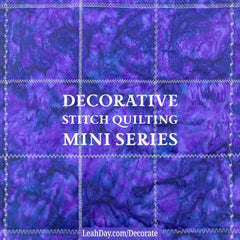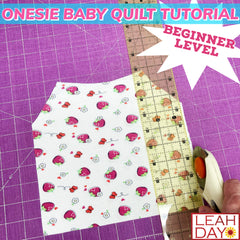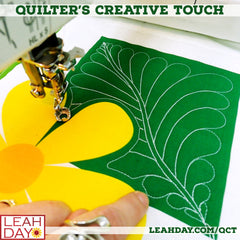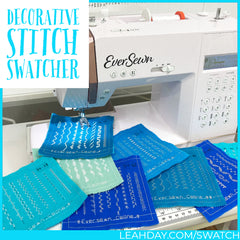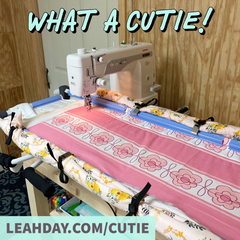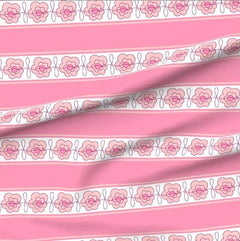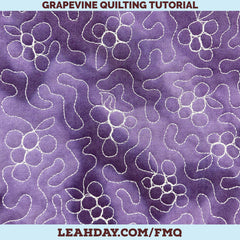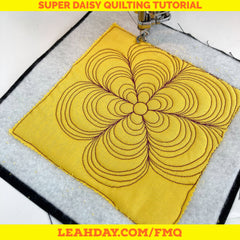Let's learn how to best set up our sewing tables for machine quilting so you feel comfortable and quilting feels as easy as it can! In this post I'll share all my tips and tricks for setting up your sewing table so it supports your quilt, your body, and your craft.
Are you ready to start machine quilting on your home machine? Jump ahead to the part of this quilting tutorial you most need to read:
Table of Contents
- Use a Flatbed or Drop Down Sewing Table
- Special Requirements for Machine Quilting
- Tip 1 - Stop Your Quilt Falling Off the Table Top
- Tip 2 - Add Space Behind Your Sewing Machine.
- Tip 3 - Extend the Left Side of Your Sewing Table
- Tip 4 - Support Your Body with an Adjustable Height Chair
- Helpful Tools for Machine Quilting
Use a Flatbed or Drop Down Sewing Table
Sewing tables can be found under lots of names: flatbed sewing table, drop down sewing table, quilting sewing table, etc. These special sewing tables are designed with a chunk of the table top cut out and a platform built underneath to support your home sewing machine.
This platform is dropped down lower than the table height so that the needle area on the sewing machine is flush with the table top. Having the needle area, or machine bed, flush with the table top makes quilting much, much easier.
Instead of pushing and pulling the quilt up and over the arm of the sewing machine, you can gently push the quilt and it will side easily over the flat table surface.
If you've never sewn or quilted on a flatbed sewing table before, you are in for a treat! This makes such a difference in the feel of quilting. The weight and inertia of the project is no longer pulling against you.
Of all the investments I've made into sewing or quilting before becoming a professional, getting my first flatbed sewing table made the biggest difference in how easy machine quilting felt and how much I enjoy it.
~ Leah Day
Click Here to find many affordable sewing tables in a wide range of sizes and prices!
Special Requirements for Machine Quilting
For the most part, you can set your sewing machine into a tiny flatbed sewing table and be able to sew garments, piece quilts, and applique just about anything you want.
However, for machine quilting even a small quilt, you may want to spend a bit more time setting up your sewing machine so it works best for moving the quilt over the surface. And the bigger the quilt you want to quilt on your home machine (yes, you can quilt a king on your home machine), the more you're going to need to think about the following pain points:
- How to make quilting feel easier - less strain on your arms and back.
- How to keep the quilt on the table - so it doesn't flop off and ruin your day.
- How to manage the bulk of the quilt so it's on the table - not on your lap.
Here's a super short video on how I recommend setting up your sewing table for machine quilting:
Tip 1 - Stop Your Quilt Falling Off the Table Top
You can have the biggest sewing machine cabinet in the world, but if your quilt slips off the side, it's going to yank the entire project to the floor. If only we could quilt in space with zero gravity...
Since gravity isn't going anywhere on Earth anytime soon, it's important to consider the position of your sewing table first. Try to set your sewing table or quilting cabinet into a left corner. This way the left side and back of the table is pushed against walls.

Why these sides? If the quilt is going to fall off the top, it will be in those directions.
If you absolutely can't position your quilt into a left corner, then you can use the new Quilt Blocks invented by my friend Christa Watson. These act like a barrier to your quilt slipping off your table edges.
Tip 2 - Add Space Behind Your Sewing Machine
When machine quilting, you need a large, flat, smooth surface to support the weight of your quilt and make it quick and easy to shift on the table top. The bigger and heavier your quilt, the more challenging it will feel to move and the more strain you will put on your back and shoulders.
Having additional space directly behind your sewing machine will help support your quilt and make machine quilting feel easier. The easiest way to expand the surface of your sewing table is to add folding tables to the back and left sides.
Folding tables are widely available at most hardware stores in both 3 x 6 foot and 2 x 4 foot sizes. Expand the surface area of a small flatbed sewing table with a 6 foot folding table to the back and another 6 foot folding table to the left side, and you will have a stable, flush surface big enough to support the weight of even a king sized quilt.
Did I mention I have quilted a king sized quilt on a home sewing machine? If I can do it, so can you!
Tip 3 - Extend the Left Side of Your Sewing Table
To best support a big quilt, try to extend the left side of your sewing table so it extends beyond your sewing machine by 2-3 feet.
This extended space will really come in handy for bigger quilts. In the natural movement of machine quilting, the quilt will want to slide forward and flop into your lap if it can.
More table surface to the left side specifically can help support your quilt and stop it from becoming a new cat.
Tip 4 - Support Your Body with an Adjustable Height Chair
While most of our focus when machine quilting is on our sewing machine and sewing table, you should also take a look at the chair you're using for quilting too. Having a chair that can adjust in height to help you feel most comfortable is essential for quilting or sewing for long hours.
Please make sure your body is properly supported and that your back, neck, and arms are positioned to reduce strain and tension. Being able to adjust your chair height can make a big difference when machine quilting.
Helpful Tools for Machine Quilting
Setting up your sewing machine properly will make an enormous difference for your ability to machine quilt easily. The following tools can also make machine quilting much easier, especially on a small machine:
- Quilting Gloves - Free motion quilting is so much easier and less frustrating when you can increase the grippability of the quilt. The only way to do this is to wear special quitling gloves designed to be useful as well as comfortable.
- Free Motion Glider - Even with a flush surface, you will still experience friction and drag working against you. To reduce this considerably, try this special Teflon coated sheet specially designed to make your quilt slide effortlessly over your machine.
- Isacord Embroidery Thread - This is my favorite thread for all types of machine quilting and machine embroidery. It's thin, strong, very affordable, and comes in 1000 meter cones which supplies enough thread to quilt a throw sized quilt.
If you'd like to make machine quilting feel as easy as possible, find all three quilting tools in our Machine Quilting Kit.



